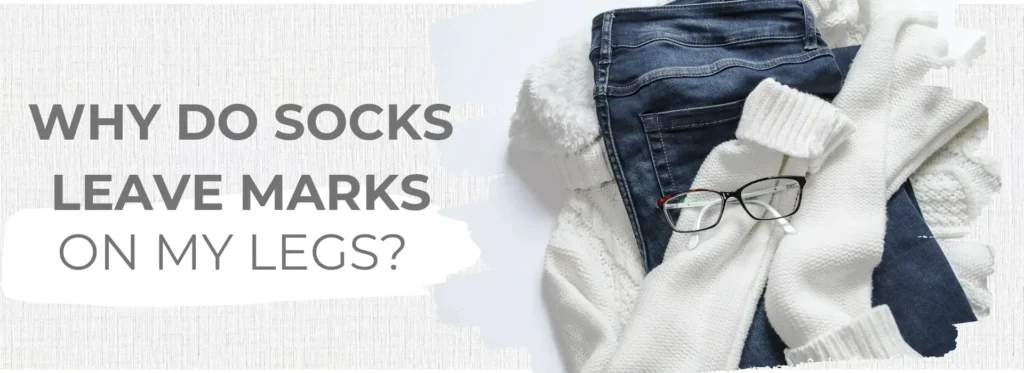Why Do Socks Leave Marks On My Legs?
Have you ever removed your socks after a long day and noticed faint indents or red marks around your legs? These sock marks can be a surprising sight and might even leave you wondering if there’s something wrong. Rest assured, for most people, these marks are completely normal. However, there are instances where they may indicate an underlying health issue. In this blog, we’ll explore the reasons behind Socks Leave Marks, when they’re harmless, and when they might signal a cause for concern.
Understanding Sock Marks
Sock marks occur due to the compression or pressure exerted by the elastic in the socks. The skin is temporarily indented because it is pliable and reacts to the consistent tightness of the sock band. While these marks are usually benign, their appearance can be influenced by various factors, including:
- Sock Material and Elasticity: Socks made with strong elastic bands or less flexible materials are more likely to leave noticeable marks.
- Duration of Wear: The longer you wear socks, the more pronounced the marks may be.
- Skin Sensitivity: Some individuals have more sensitive or impressionable skin, making marks more visible.
When Sock Marks Are Normal
In most cases, sock marks are nothing to worry about. Here’s why they occur under normal circumstances:
1. Elastic Compression
Socks need elastic bands to stay in place on your legs. These bands apply a mild, consistent pressure, which temporarily indents the skin. This is similar to how a watch strap or a ring may leave an impression after prolonged wear.
2. Fluid Accumulation
Throughout the day, gravity causes fluids to accumulate in the lower extremities, especially if you’ve been standing or sitting for extended periods. This mild swelling, known as edema, is usually harmless and can make sock marks more prominent.
3. Individual Skin Characteristics
People with softer or thinner skin may notice sock marks more easily than those with firmer skin. Age, hydration levels, and skin elasticity also play a role in how pronounced these marks appear.
When Sock Marks Could Be a Concern
While sock marks are typically benign, there are situations where they might indicate a deeper issue. Persistent or severe marks could point to:
1. Edema (Swelling)
Edema refers to the buildup of fluid in tissues, which can cause swelling in the legs, ankles, and feet. Common causes of edema include:
- Prolonged Standing or Sitting: Long periods of immobility can lead to temporary swelling.
- Pregnancy: Hormonal changes and increased blood volume can cause mild swelling, especially in the third trimester.
- Heat: Warm weather can dilate blood vessels and lead to fluid retention.
2. Circulatory Issues
Problems with blood circulation can also lead to swelling and sock marks. Conditions to watch for include:
- Venous Insufficiency: When the veins in your legs struggle to return blood to the heart, it can result in pooling and swelling.
- Deep Vein Thrombosis (DVT): A blood clot in a deep vein may cause noticeable swelling, discomfort, and persistent marks.
3. Kidney or Heart Conditions
Chronic health issues like kidney disease or congestive heart failure can lead to fluid retention and more pronounced sock marks. If these marks are accompanied by other symptoms such as shortness of breath, fatigue, or sudden weight gain, seek medical advice promptly.
4. Lymphedema
This condition occurs when the lymphatic system, which helps drain excess fluid, is impaired. It can cause significant swelling and sock marks that don’t fade quickly.
How to Prevent or Minimize Sock Marks
If sock marks bother you or if you want to reduce their appearance, consider the following tips:
1. Choose the Right Socks
Opt for socks that:
- Have a looser band or no elastic at all (e.g., diabetic or compression socks).
- Are made from stretchy, breathable materials like cotton or bamboo.
- Fit properly without being overly tight.
2. Elevate Your Legs
If fluid retention is causing visible sock marks, elevate your legs above heart level for 15-20 minutes. This helps reduce swelling and improves circulation.
3. Stay Hydrated
Dehydration can worsen fluid retention. Drinking enough water throughout the day helps maintain proper fluid balance in your body.
4. Move Regularly
Avoid sitting or standing in one position for too long. Gentle stretching or walking can prevent fluid from pooling in your legs.
5. Use Compression Socks
Ironically, while tight socks might cause marks, properly fitted compression socks can help improve circulation and reduce swelling, especially if you’re prone to edema.
When to Consult a Doctor
If sock marks are accompanied by any of the following symptoms, it’s a good idea to seek medical attention:
- Persistent or worsening swelling.
- Pain or tenderness in the legs.
- Skin discoloration or ulcers.
- Shortness of breath or chest pain.
- Sudden weight gain or fatigue.
These signs could indicate a more serious underlying condition, such as a circulatory or systemic health issue.
The Bottom Line
Sock marks are a common occurrence and are usually nothing to worry about. They’re often the result of elastic pressure or mild fluid retention. However, if these marks are persistent, severe, or accompanied by other symptoms, they may signal an underlying health problem that requires attention.
Understanding the factors contributing to sock marks can help you make informed decisions about your footwear and overall health. Whether choosing better-fitting socks, staying active, or seeking medical advice when needed, small steps can go a long way in ensuring your comfort and well-being.
